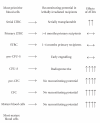Roles of retinoids and retinoic Acid receptors in the regulation of hematopoietic stem cell self-renewal and differentiation
- PMID: 17846663
- PMCID: PMC1950592
- DOI: 10.1155/2007/87934
Roles of retinoids and retinoic Acid receptors in the regulation of hematopoietic stem cell self-renewal and differentiation
Abstract
Multipotent hematopoietic stem cells (HSCs) sustain blood cell production throughout an individual's lifespan through complex processes ultimately leading to fates of self-renewal, differentiation or cell death decisions. A fine balance between these decisions in vivo allows for the size of the HSC pool to be maintained. While many key factors involved in regulating HSC/progenitor cell differentiation and cell death are known, the critical regulators of HSC self-renewal are largely unknown. In recent years, however, a number of studies describing methods of increasing or decreasing the numbers of HSCs in a given population have emerged. Of major interest here are the emerging roles of retinoids in the regulation of HSCs.
Figures


Similar articles
-
Protagonist or antagonist? The complex roles of retinoids in the regulation of hematopoietic stem cells and their specification from pluripotent stem cells.Exp Hematol. 2018 Sep;65:1-16. doi: 10.1016/j.exphem.2018.06.287. Epub 2018 Jul 4. Exp Hematol. 2018. PMID: 29981365 Review.
-
Cell division and hematopoietic stem cells: not always exhausting.Cell Cycle. 2005 Jul;4(7):893-6. doi: 10.4161/cc.4.7.1831. Epub 2005 Jul 7. Cell Cycle. 2005. PMID: 15970708
-
Uhrf1 controls the self-renewal versus differentiation of hematopoietic stem cells by epigenetically regulating the cell-division modes.Proc Natl Acad Sci U S A. 2017 Jan 10;114(2):E142-E151. doi: 10.1073/pnas.1612967114. Epub 2016 Dec 12. Proc Natl Acad Sci U S A. 2017. PMID: 27956603 Free PMC article.
-
Life and death in hematopoietic stem cells.Curr Opin Immunol. 2007 Oct;19(5):503-9. doi: 10.1016/j.coi.2007.05.001. Epub 2007 Jul 6. Curr Opin Immunol. 2007. PMID: 17618101 Review.
-
Rb is dispensable for self-renewal and multilineage differentiation of adult hematopoietic stem cells.Proc Natl Acad Sci U S A. 2006 Jun 13;103(24):9057-62. doi: 10.1073/pnas.0603389103. Epub 2006 Jun 5. Proc Natl Acad Sci U S A. 2006. PMID: 16754850 Free PMC article.
Cited by
-
RARγ is essential for retinoic acid induced chromatin remodeling and transcriptional activation in embryonic stem cells.J Cell Sci. 2013 Feb 15;126(Pt 4):999-1008. doi: 10.1242/jcs.119701. Epub 2012 Dec 21. J Cell Sci. 2013. PMID: 23264745 Free PMC article.
-
Retinoic Acid Negatively Impacts Proliferation and MCTC Specific Attributes of Human Skin Derived Mast Cells, but Reinforces Allergic Stimulability.Int J Mol Sci. 2017 Feb 28;18(3):525. doi: 10.3390/ijms18030525. Int J Mol Sci. 2017. PMID: 28264498 Free PMC article.
-
Rara haploinsufficiency modestly influences the phenotype of acute promyelocytic leukemia in mice.Blood. 2011 Feb 24;117(8):2460-8. doi: 10.1182/blood-2010-08-300087. Epub 2010 Dec 29. Blood. 2011. PMID: 21190992 Free PMC article.
-
Whole-genome resequencing reveals genomic variation and dynamics in Ethiopian indigenous goats.Front Genet. 2024 May 24;15:1353026. doi: 10.3389/fgene.2024.1353026. eCollection 2024. Front Genet. 2024. PMID: 38854428 Free PMC article.
-
Mesenchymal lineage cells and their importance in B lymphocyte niches.Bone. 2019 Feb;119:42-56. doi: 10.1016/j.bone.2017.11.018. Epub 2017 Nov 26. Bone. 2019. PMID: 29183783 Free PMC article. Review.
References
-
- Allen TD, Dexter TM, Simmons PJ. Marrow biology and stem cells. Immunology Series. 1990;49(1):1–38. - PubMed
-
- Zhang J, Niu C, Ye L, et al. Identification of the haematopoietic stem cell niche and control of the niche size. Nature. 2003;425(6960):836–841. - PubMed
-
- Calvi LM, Adams GB, Weibrecht KW, et al. Osteoblastic cells regulate the haematopoietic stem cell niche. Nature. 2003;425(6960):841–846. - PubMed
-
- Clagett-Dame M, DeLuca HF. The role of vitamin A in mammalian reproduction and embryonic development. Annual Review of Nutrition. 2002;22:347–381. - PubMed
LinkOut - more resources
Full Text Sources

